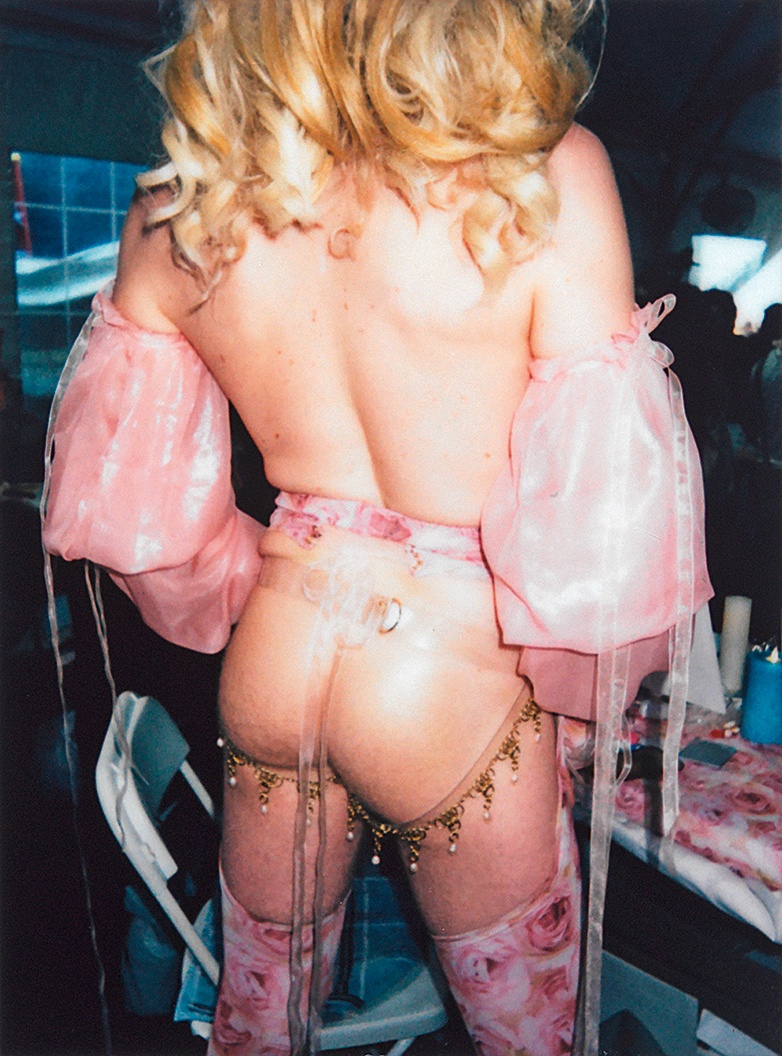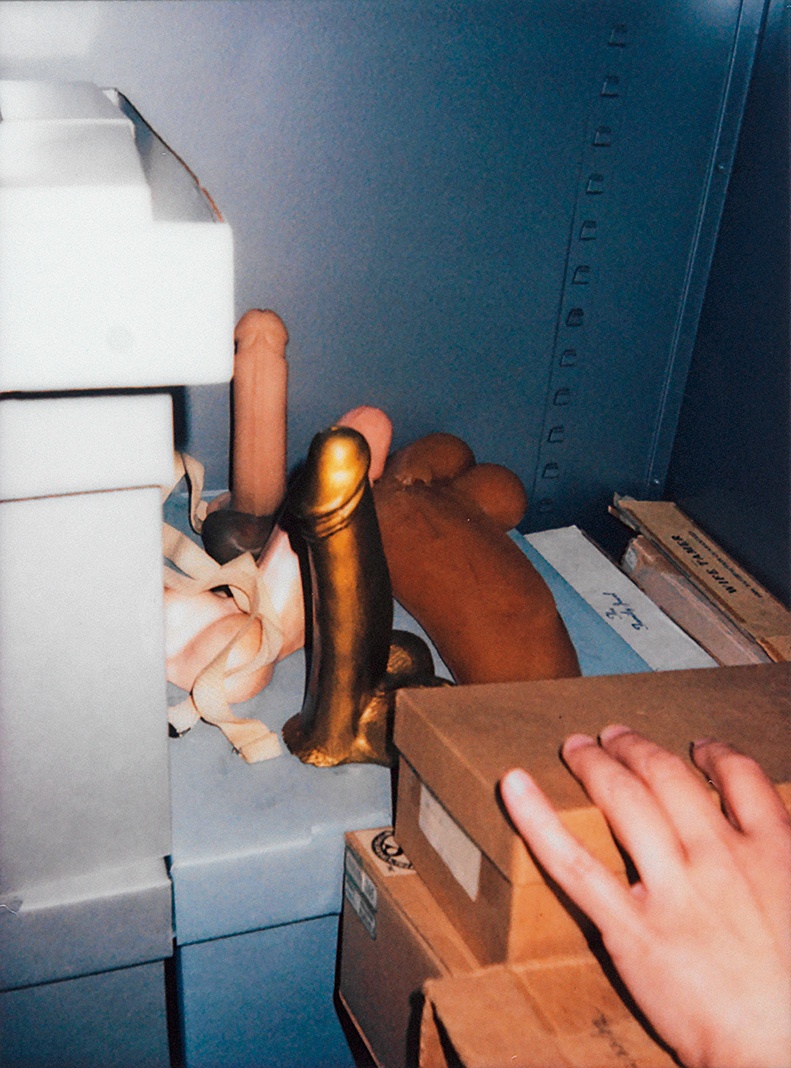DILDOS, DRAG QUEENS, AND LOTS OF DOLLY PARTON Matthew Jeffrey Abrams on “Valid Until Sunset” by Jarrett Earnest

Jarrett Earnest, “07.09.2021 – Wamego, Kansas,” 2021
I
The Polaroid is a bit blurred, but there is no doubt: that’s Dorothy from The Wizard of Oz. There are her famous braids tied up with those famous blue ribbons. There is young Judy Garland, walking the yellow brick road. But Jarrett Earnest’s prolonged exposure, one of the sixty or so Polaroids anchoring Valid Until Sunset, has smeared Dorothy’s face across the emulsion. Likely captured in a darkened movie theater, the girl now seems to effervesce. Dorothy, mid-stride, looks up toward another character. She holds a curious glance, as if about to ask a question. At what point in the movie is this? Who is that gray-brown figure ahead of her? Perhaps the Scarecrow? The Lion?
The adjoining anecdote helps ground us. Earnest is in Wamego, Kansas, “a rural agricultural town trying to rebrand as an Oz-themed tourist attraction, starting with the Oz Museum in 2004” (p. 111). [1] Earnest’s friend Haya Kim, we learn, was once a curator there. And now Earnest has made his own pilgrimage to Wamego’s Oz Museum:
Walking through the displays at the museum, you see replicas of the muslin tube that was used to film the “twister” among cases of photographs, ephemera, and dolls. In the back is a small theater that plays the 1939 movie on repeat. How touching to think that all day, every day, there’s this little room out in Kansas playing The Wizard of Oz on a loop – part conceptual art, part “gay church.” (p. 111)
A beloved film and a cherished children’s book. A camp anthem and a queer icon – all this and more now enshrined in the great “gay church” of Wamego, Kansas. Earnest conveys the ambivalence and absurdity that one can only find in the middle of rural North America. And he marks that ambivalence in his Polaroid from the Oz Museum’s theater: an unclear image of an unstable symbol. Dorothy as a shimmering, high-camp Madonna.

Jarrett Earnest, “07.09.2021 – Wamego, Kansas,” 2021
II
Valid Until Sunset is a hybrid project that is equal parts photobook, memoir, and art criticism. Practically speaking, the book recounts a series of moments in Earnest’s life and those of his close friends. There are 60 diptychs of a sort – a Polaroid facing a brief anecdote. They appear chronologically, from February of 2016 to October of 2022 – about six and a half years.
Using this format, Earnest combines the folksy with the queer; Southern hospitality with gay sexuality. In Valid Until Sunset he invites us to take a campy, erotic journey across the US. Like a Bible Belt Tom of Finland, he guides us from city to city, body to body, and cock to cock.
This makes Valid Until Sunset unique. Yes, it celebrates the queer community. But it also celebrates the US countryside and the great North American road trip, which, as Earnest slyly illuminates, can be pretty fucking queer itself.
III
“MY SPOUSE IS AWAY” reads the enigmatic sign. It stands somewhere in Illinois alongside Interstate Highway 74. It sprouts from the ground much like the crops behind it. “You think you must have missed something,” Earnest writes. “Another sign that would make the message legible as an advertisement or political statement or a Bible thing.” But no. Just this one proclamation. “Is this some kind of kinky signal?” Earnest wonders. “My spouse is away … so come fuck me. Or a lament?” (p. 123) The Polaroid gives nothing away. Everything is in soft-focus, the landscape as hazy as the sign’s intent.
Earnest embraces chance encounters. Hence his love for solo cross-country drives, where North America can always surprise. Notably, Earnest opens Valid Until Sunset with a line from André Breton’s celebrated Surrealist novel Nadja – another commentary on wandering, chance, and sexual potential. And, as it happens, photography too.
In Nadja, Breton and his paramour wander a space filled with an indistinct but omnipresent sexual energy – the streets of Paris. [2] In Valid Until Sunset Earnest more or less does the same, only he’s not walking the banks of the Seine: he’s driving the highways of the US.
And much like Nadja, Valid Until Sunset is a project very interested in the way images work. [3] Elsewhere, Earnest defines his project as a “method for understanding images, symbols, etc.” Accordingly, many of Earnest’s anecdotes include meditations on such a practice.
The meditations are glancing but provocative. “You tell Candystore that when Sinéad [O’Connor] tore up that photo on live television,” one begins, “it was the single most eloquent statement on the nature of images and power” (p. 79). Indeed, when the Irish singer tore up that photo, she effectively tore up her career. It’s a canny observation on photography and iconoclasm, from both Earnest and O’Connor.
Such are the tales of Jarrett Earnest. Like a cartographer of queerness, he motors across the continent, charting alternate versions of the US along the way – ones brimming with dildos, drag queens, and lots of Dolly Parton.

Jarrett Earnest, “09.06.2018 – Bloomington, Indiana,” 2018
IV
Valid Until Sunset is by turns sad and affirming, confessional and philosophical. It’s also naughty, frothy, and downright tawdry.
“Silk as a faggy odalisque,” another anecdote begins, this one dated April 25, 2017, Brooklyn, New York. “It’s kind of a creepy thing to do,” Earnest goes on to say, “towering over a naked person. It’s also funny – a parody of the power dynamics of fucking and photographing. Lube and sweat and cum darken Silk’s pink sheets, creating a temporary stain painting” (p. 41).
There’s a small, tender smile on Silk’s face. His lithe body curves in opposite directions. His torso rolls right; his legs roll left. His limbs appear to hang heavily, perhaps in some post-coital exhaustion. And there is the stain painting, still in the making, beneath his angelic form.
V
But I think my favorite thing about Valid Until Sunset is its evocation of community. I’m particularly fond of the entry dated September 21, 2019, from Queens, New York.
Earnest’s partner, Candystore, has recently won a prize from the Printed Matter Art Book Fair. The award includes some cash and a booth at the upcoming fair. Earnest later photographs Candystore while selling her chapbook Hi Angels in the zine tent. He recalls the moment in detail:
Candystore wears a custom outfit from Haus of Garbage: rose-print spandex assless bell-bottoms with puffy pink chiffon sleeves. She asks you to brush gold highlighter on her ass cheeks. A small altar to Jerome with a framed portrait is set up in the middle of the table, surrounded by copies of the book. The rest of the money goes to hiring Charlene and Serena Tea, the newly crowned Miss Bushwig, to make an unannounced and unsanctioned drag performance with a boombox in the aisle of the crowded fair like the showtime boys on the subway. (p. 83)
What a lovely image: Miss Bushwig detourning the art fair, using art fair funds no less. Valid Until Sunset does this often: it dwells on those moments when a community manifests itself most powerfully, like during performances and rituals. Transitory moments. Earnest writes elsewhere that as this project matured, photography became more and more “just about light in all its fleeting contingency” (p. 24). And that’s precisely what Valid Until Sunset records: flashes of “queer self-invention” in all their own “fleeting contingency” (p. 107).
Jarrett Earnest, Valid Until Sunset, New York: MATTE Editions, 2023, 160 pages.
Matthew Jeffrey Abrams is a writer and art historian. His writing has appeared in The Guardian, BOMB Magazine, Conjunctions, and elsewhere.
Image credit: Courtesy of Jarrett Earnest
Notes
| [1] | Unless otherwise noted, all quotations are taken from Jarrett Earnest, Valid Until Sunset (New York: MATTE Editions, 2023). |
| [2] | I’m thinking here also of Breton’s famous sexualization of the triangular Place Dauphine as “la sexe de Paris.” See André Breton’s essay “Pont-Neuf” in André Breton, La clé des champs (Paris: Pauvert, 1979), 228–34. |
| [3] | Nadja was also a hybrid photography-writing project. |
